A Shape that Flatters.
When you choose a dress that enhances your natural shape, you will be guaranteed to look and feel more confident and beautiful than ever on your special day. To determine your silhouette, get in front of the mirror in a bathing suit or better yet, au naturale.
Do you have hips and chest roughly the same dimension with a slender waist? Lucky you! You have an hourglass figure! One of the most versatile shapes, you can wear almost any kind of dress. Just stay away from empire waists or puffy skirts, which might make you look out of proportion.
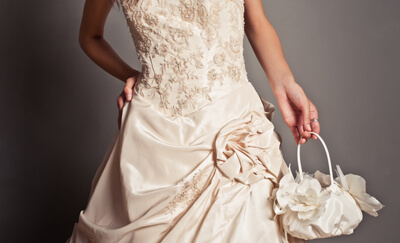
When you choose a dress that enhances your natural shape, you will be guaranteed to look and feel more confident
Are you short-waisted? This means that the difference from your ribs to your hips is shorter than average, although your other proportions are spot on. In this case, a dropped waist dress can elongate your torso -- but don’t opt for a sheath, it will call attention to your short waist.
If your waist is undefined, resulting in a straight line from shoulders to hips, then you have an athletic, or boyish, figure. Choose an empire-waist dress to downplay your waist and lengthen your figure.
You voluptuous beauties with full breasts and hips and a little tummy should opt for a ball dress style to camouflage any extra weight and smooth your silhouette. A-line styles are appropriately slenderizing but stay away from sheaths, which emphasize a body’s curves.
If you are small on top with heavier hips and thighs, then you are a classic pear. Emphasize your lovely neckline and arms with a strapless ball gown or an empire style. Don’t choose a dress that hugs your lower half, as it will make you seem out of proportion.
Finally, if you are very thin or petite, stay away from large, elaborate gowns that can overwhelm your figure and hide your natural assets. Almost any other type of dress will flatter you.
A Style to Call Your Own.
Now that you’ve determined your shape and have some idea of what types of gowns will flatter, let’s look at popular dress styles and their definitions.

The Ballgown wedding dress is classic princess style, featuring a nipped in waist with a very large and voluminous skirt.
The Ball Gown
This is the dress every young girl thinks of when daydreaming about their wedding day. Usually composed of a fitted bodice with a very full, floor length skirt, this dress makes a dramatic statement. It is flattering to most figure styles and lends itself to both day and evening weddings.

Fishtail or Mermaid wedding gowns have a feminine and sexy shape, clinging to all the curves. If you've a great bum - this will be the look for you!
The Mermaid
This extremely form fitting dress is very sexy and appropriate for the confident, well-proportioned bride. It hugs the body tightly all the way to the knees, where it flares out in a swirl of fabric. Even though it is quite sophisticated, it can also work for beach weddings and more casual venues in the proper fabric.
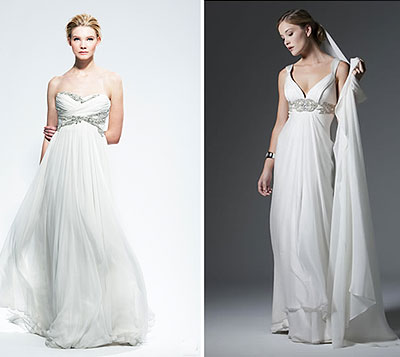
Empire line dresses gather just under the bust and fall gently over the hips. These are perfect for ladies who don't love their tums, bum or legs.
Empire Waist
Empire waist gowns, popularized by Josephine Bonaparte, Napoleon’s love, are wonderful for almost all figure shapes, especially those with thick waists or small bosoms. However, if you are large-breasted this style should be avoided as it can make you look matronly.

Sheath dresses are for the tall, slim and willowy, essentially because they're the most unforgiving of all wedding dress styles.
Sheath
This simple dress is columnar, falling straight from the neck to hem. While it is a popular choice for weddings, you should avoid this if you are full-figured or are not evenly proportioned (large hips--small bust, for instance) as it will only emphasize the disparity.
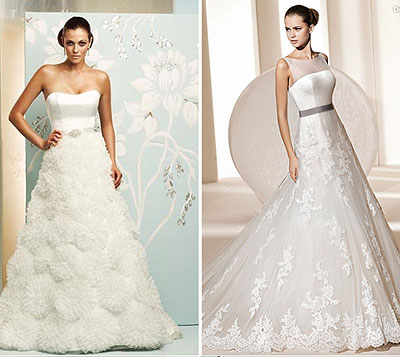
An A-Line skirt has a lot less volume than a ballgown but still gives that classic princess dress shape. great for all body types, giving an hourglass shape.
A-Line
The most popular of all styles, the a-line flatters most figures. It hugs the bodice and then flares into an “A” shape at the skirt, camouflaging minor flaws and helping correct proportions. Lengthening and slimming, this dress can make you appear taller and more slender, an advantage for any bride!
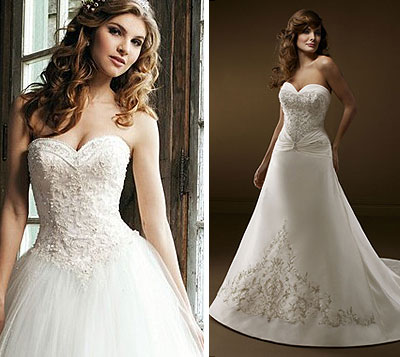
The Basque waist falls just below the natural indentation of the waist and is a great style for drawing attention to the waist and will disguise a small tummy.
Basque Waist
This is a lovely dress style with roots in the courts of Europe and in medieval Great Britain. A relatively fitted bodice comes to a point or “V” before falling into a fuller skirt. The “V” shape naturally elongates and adds height while the full skirt hides heavy lower bodies or prominent tummies.
A Word about Theme.
Now that you have some ideas of what your perfect dress should look like you should take into consideration the theme of your wedding. Wedding dresses don’t have to be white anymore, so if you have a colorful theme, feel free to consider a dress in any color that will enhance your scheme.
Perhaps your theme is less about color and more about heritage or tradition. A Celtic or Irish-themed wedding offers the bride a wide variety of stunning choices for wedding apparel. Many Celtic dresses are patterned after the lovely and popular basque-waisted gowns, which offer a romantic and time-honored look. Sleeves are often long and filmy, with gauzy points that fall below the fingertips. Material can be either heavy, like velvet, or diaphanous gauze and silk depending on the bride’s wishes.
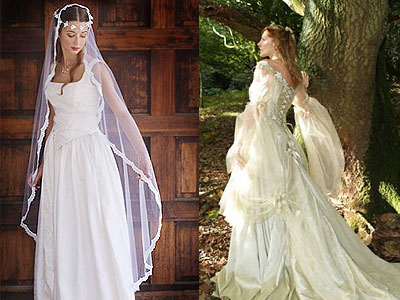
With the right dress, a Celtic themed wedding can become a truly magical affair
Maybe you are planning a destination wedding. If you are considering the British Isles, then a Celtic or Irish style will be perfect. An island destination means a more informal choice and of course, lighter materials. A ski wedding locale gives you the option of many non-traditional choices, like cloaks or capes in lieu of a veil and fur trim for your dress.
Tis the Season.
Wearing a strapless gown to a winter ceremony might bring a chill to your day, so consider the time of year you plan to wed when choosing your dress. Materials like heavy silks, velvets, and heavy satins will be best for chillier climes or fall and winter seasons. Cold-weather wedding gowns lend themselves to ornate and heavy embellishment, so if you are wanted to sparkle with abandon an off-season wedding might just be for you.
If you are planning a traditional spring or summer wedding then laces, sheer fabrics like tulle, organza and chiffon and even nontraditional materials such as cotton and linen can be wonderful choices. These work well in a temperate season or for a warm destination. Celebrate the balmy breezes with off-the-shoulder styles, shorter dresses, and filmy materials.
Consider the Budget.
Don’t let a small budget cramp your creative style when it comes to your dream wedding dress. There are plenty of choices that don’t require a great deal of money and still look fabulous. Consider the rented gown--there are oodles of gorgeous dresses for rent at 1/4 the cost of a purchased dress. If you must own your dress, consider shopping at a consignment store for a “gently used” dress. After all, the bride only wore it for one day! If you find the consignment dress of your dreams but it isn’t your size, don’t despair--a tailor can make the alterations without breaking the bank. In fact, if you love simple dresses and are wise with fabric choices, going to a local tailor for a bespoke dress can save you money.
Thinking outside the box when choosing a dress can also be a budget-friendly choice. Not all wedding dresses have to be white with a five foot satin train. You can find white or ivory dresses in many department stores that can work right off the rack or with small alterations and you will save thousands because it wasn’t labelled a “wedding” dress. Colored gowns lend themselves to this little trick, as do some themed wedding gowns like Celtic and Irish ones. You can find Celtic and Irish gowns online in abundance due to the growing popularity of Renaissance fairs. Some can even be made to your color and size specifications for a fraction of the cost of a traditional wedding dress.
Finally, don’t leave out the possibility of remaking your mother or grandmother’s dress to suit your own style. It’s comforting to know that there is a dress for every figure, style, theme and budget all just waiting to be discovered. So grab your notes and maybe a friend or two and get shopping!
Did You Know?
Traditionally, Irish brides wore blue wedding dresses instead of white. Blue was a symbol of purity to the ancient Celts. In fact, it wasn’t until 1499 that Anne of Brittany popularized the white wedding dress.
Irish wedding dresses are often embellished with Irish lace, which dates as far back as the 16th century. In 1845, the Ursuline Sisters set up a crochet center in Blackrock, County Cork to provide employment during the Great Potato Famine, which led to the popularization of the lace in America and abroad.
Irish brides carried a handkerchief on her wedding day to symbolize fertility. It was usually tucked into the sleeve of the wedding dress or carried with the bouquet. When the wedding was over, the bride would use the kerchief to make a christening bonnet for her first child.




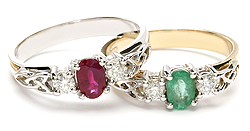
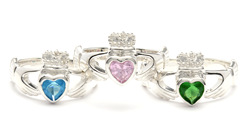
 Princess Engagement Ring
Princess Engagement Ring  Celtic Knot Engagement Ring
Celtic Knot Engagement Ring  Emerald Engagement Ring
Emerald Engagement Ring 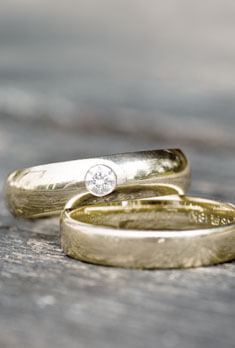

 Trinity Inset Wedding Ring
Trinity Inset Wedding Ring  Emerald Trinity Knot Ring
Emerald Trinity Knot Ring  Trinity Knot Diamond Ring
Trinity Knot Diamond Ring